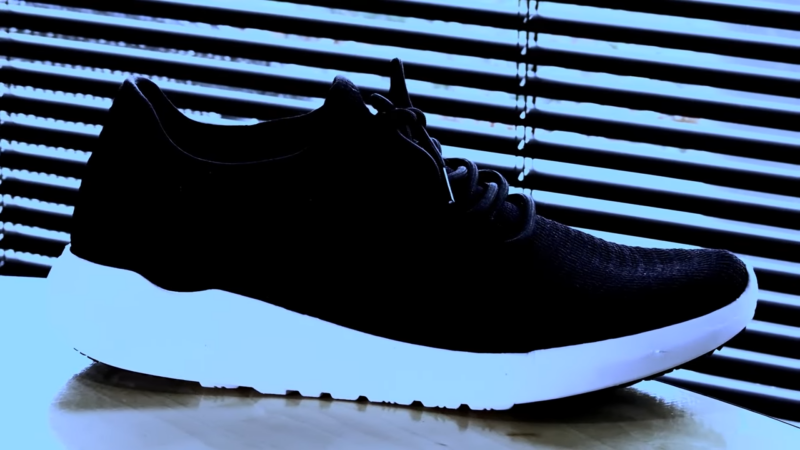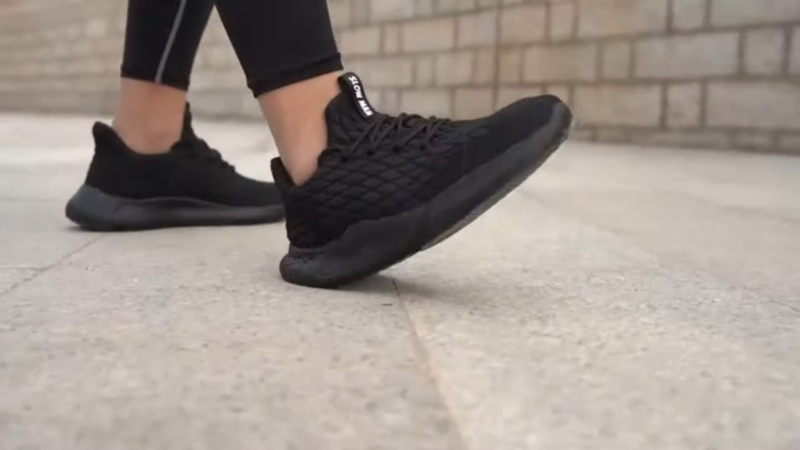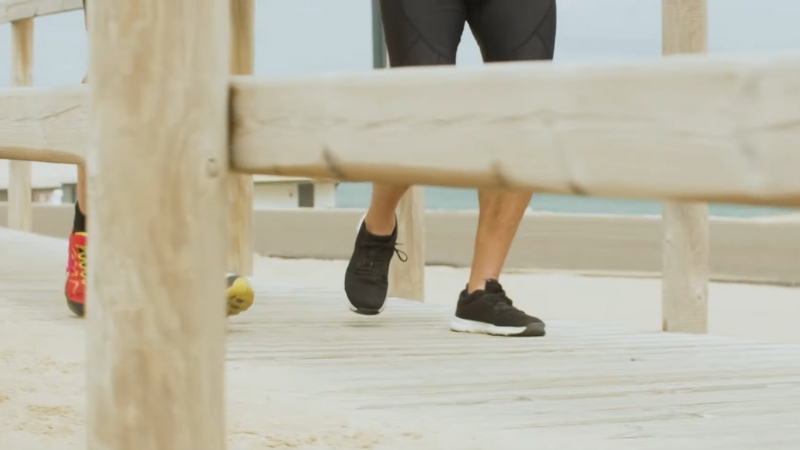One of the most common things that new runners ask about is how to find the most comfortable and durable pair of running shoes.
t’s understandable to wonder which types of shoes will provide the best support and reduce the chance of injury. I have recently received some questions about whether memory foam shoes are good for running.
I understand where the question is coming from because they have become increasingly popular lately.
Memory foam provides some of the most comfortable shoes. I decided to do a deep dive into the pros and cons of memory foam shoes to help you determine if they are good for running.
What Are Memory Foam Shoes?

Memory foam shoes are a type of shoe that is made of a special material called polyurethane.
You have probably heard of memory foam mattresses and pillows because they seem to be increasingly common.
Memory foam shoes are a very comfortable type of shoes that are increasing in popularity.
There are many benefits to wearing them, which is why so many runners have been curious about whether they may also be a good fit for running.
What Are The Benefits of Memory Foam Shoes?
Memory foam shoes actually have a lot of benefits. I will provide a few examples of the benefits below.
Provide Support
The biggest benefit of memory foam shoes is the support they provide. Memory foam shoes offer excellent arch support.
They also provide sole support. Because of this, the shoes can reduce and ease pain on the balls of your feet.
It is very common for people who have jobs where they work long hours to stand for long periods of time (nurses, teachers, etc.) to wear memory foam shoes.
They can provide comfort when standing for long periods of time and reduce foot pain from standing and pressure.
Memory foam uses your body heat to form to your exact shape. Your body heat actually softens the memory foam and creates a mold of your body.
Improve Stability
Because memory foam shoes are made of polyurethane, which is sensitive to heat, they mold to your feet which can improve stability.
They can also provide an even distribution of balance. This can be very beneficial when standing for long periods of time.
This helps to stabilize your body weight and make it so that there isn’t an uneven distribution of weight to a certain part of your foot (which can cause pain).
Absorb Shock
@jamies.running I’ve been using @Enertor’s shock-absorbing insoles since a leg injury I had back in July. Many people have asked whether they’ve actually make a difference – my opinion is yes, they keep me in comfort for longer. Having already shared an Egg Test video to demonstrate the shock-absorption capabilities, as a bit of extra fun I came up with a way to show how they also help to enhance energy return – introducing the Coin Toss… Comparing a regular insole out of a well-cushioned everyday running shoe (the Infinity RN4) to the Enertor insoles, which one can throw a coin (the same coin!) furthest?! Anyway – they’ve worked great for me, especially over longer distances where my feet and legs would usually feel pretty beat up by the end of the run. If you’re interested to know more about my experience, drop a comment or send me a DM. You can use discount code JAMIE15 for 15% off your order. #ad #r#runnersoftiktokr#runtoinspiret#tiktokrunningt#tiktokrunnersm#marathonr#runningr#runnerh#halfmarathonm#marathonr#runningcommunitym#motivationr#runningmotivationG#GRWMA#ASMRw#whisperr#runningshoesm#marathontrainingr#runtipsrunningtips #injuryprevention ♬ original sound – Jamies.running
Another nice benefit of memory foam shoes is they absorb shock. They absorb heel and sole shock.
Each time you take a step, your foot strikes the floor which can send a shock up your foot and leg. This is caused by the impact of your foot hitting the ground.
Repetitive shock being absorbed directly by your feet and legs can lead to pain and injury.
That is why it is so important to wear shoes that will absorb shock and protect your joints and ligaments.
Prevent Pressure and Rubs
Another positive benefit of memory foam shoes is that they prevent pressure and rubs.
Choosing a pair of shoes that rubs your skin will lead to blisters and chafing. No walker or runner wants that.
Memory foam shoes help to prevent this rubbing which will also reduce your chances of getting blisters.
Reduce Risk of Injury
Do Running Shoes Cause or Prevent Injury? – What the Research Says https://t.co/gkfCqxv1yt
Nice piece in @runnersworld on the association between running injuries & footwear (hint: there’s not much evidence as @rwilly2003 & I discussed back in 2018: https://t.co/tS4ZWT4AmS).
— Chris Napier PT, PhD (@runnerphysio) December 5, 2020
Memory foam shoes are known to reduce the risk of injuries such as plantar fasciitis. Memory foam shoes have so many benefits which can lead to a lower chance of injury.
With the extra support and ease of pressure, it is easy to see why these types of shoes are becoming so popular and trendy!
What Are the Cons of Memory Foam Shoes?
While there are tons of benefits of memory foam shoes, there are also quite a few cons – especially when it comes to running!
Retain Heat

The first con of memory foam shoes is heat. Because of the material that the shoes are made of, they retain a lot of heat.
This can be good if you’re looking for a shoe that provides warmth.
When it comes to running, that is generally not the case. This can be especially bothersome in the hot summer months.
The polyurethane material that memory foam shoes are made of is very dense and doesn’t have much breathability.
This can be bad news for a runner since retaining heat while you are running is not a good thing.
Retain Sweat
Another con of memory foam shoes is sweat. Because of the dense and hot nature of the memory foam material, it can make your feet generate and retain sweat. For runners, this is an important factor to consider.
Runners typically want to look for running equipment that is light, breathable, and does not retain sweat.
Smell
Since memory foam shoes retain heat and retain sweat, it’s probably obvious that another major issue that they have is the smell.
Since the material is not breathable and it retains sweat, it will eventually lead to an unpleasant odor. It’s a good idea to leave the shoes to air out to dry in between wearings to prevent an unpleasant smell.
New memory foam also can be known to emit a chemical-like smell (referred to as off-gassing). The smell can last several weeks until it has adequate time to air out. The gasses are not harmful, but can just be bothersome.
Poor Durability

Just like many other materials, memory foam is not meant to last forever. Over time, memory foam loses elasticity and eventually begins to lose its ability to go back to its original shape.
This deterioration can counteract all the benefits that we just talked about and make it so that you are more susceptible to injury and foot pain.
What is The Final Verdict?
The answer is: it depends. Every runner has unique needs, and while memory foam can offer excellent cushioning and pressure relief, it may not be the ideal choice for everyone.
Memory foam shoes provide great support, shock absorption, and stability, which can be beneficial for runners. However, they lack certain key features essential for running shoes, such as breathability, moisture-wicking materials, and lightweight design.
Just as foot sizes vary, so do individual preferences and requirements for running shoes. Some runners find memory foam incredibly comfortable, while others feel it hinders performance.
The best advice I can offer as a running coach is to get a professional shoe fitting at a specialized running store. Experts will assess your foot structure, gait, and running style to recommend the most suitable shoes for you.
Running shoes are never a “one-size-fits-all” solution, so finding the right fit is key to comfort and injury prevention.
Related Posts:
- 25 Simple Running Motivation Tips To Get You Moving
- How Can You Start a Career as a Running Coach?
- How Far Is a Half Marathon? Everything You Need to Know
- Lower Back Pain While Running? Here's What You Need to Know
- Should You Run on an Empty Stomach? Pros and Cons Explained
- How Long Does It Take to Train for a Half Marathon?







